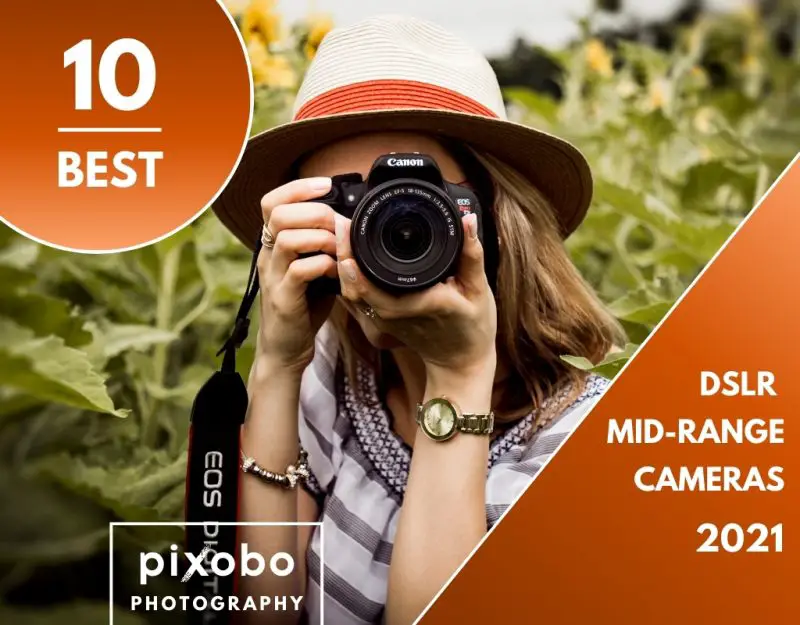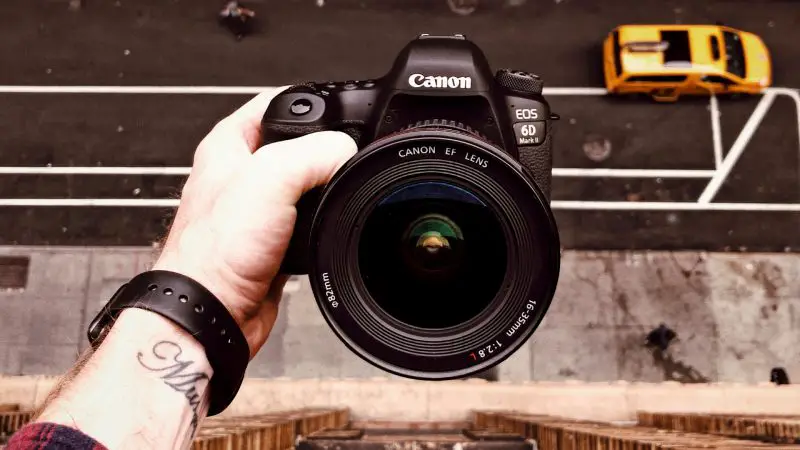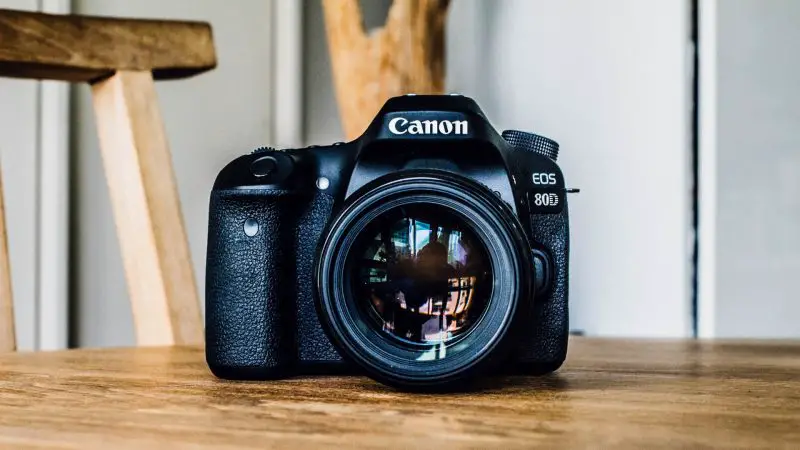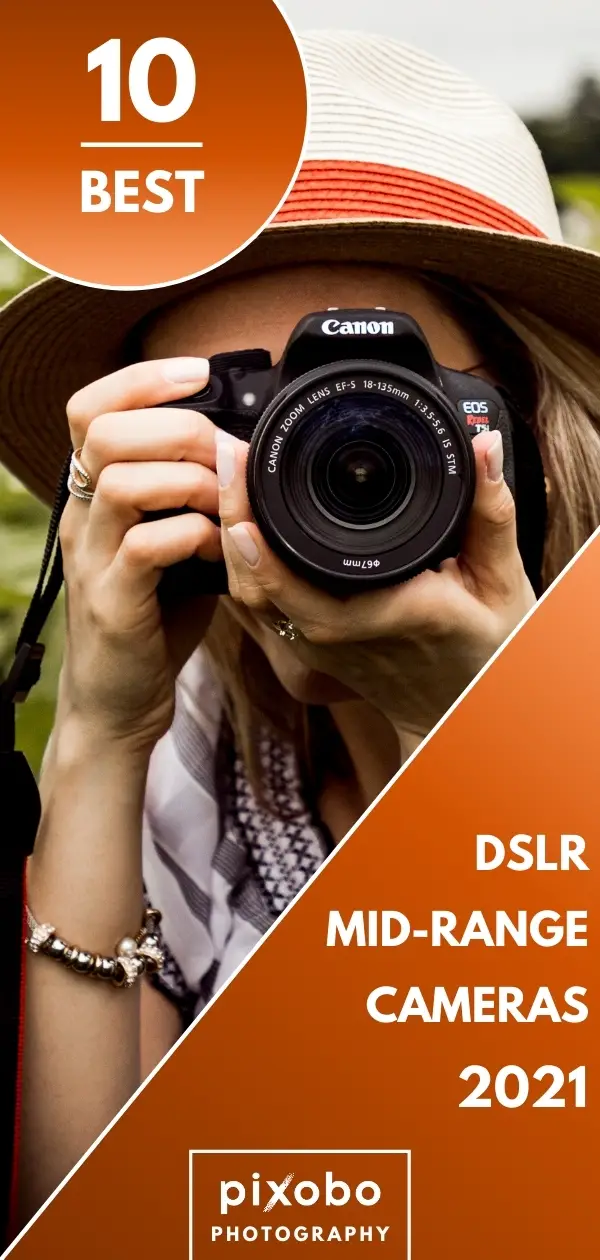
As a photography enthusiast, you might be eyeing on a new mid-range DSLR, maybe because you don’t want to settle with an entry-level DSLR that is more suited for beginners and you want something which offers more control and robustness. Maybe you want to upgrade that old entry-level DSLR you bought last year so you can turn things up a notch in your photography life. Don’t worry, we got you covered!
Here are the top 10 mid-range DSLRs for the photography enthusiasts in 2021:
Related: How to Choose the Best Camera for Your Needs – 7 Step Guide

The first few DSLRs are great all-rounders and are very versatile cameras for almost every photographic situation for competitive prices. The rest are still very good cameras with some upgrades but with steeper pricing, and some might be very good to use on a specific niche. Some of them might be a few years old already when they were first released, and that is because they are still very good when compared to current DSLR releases.
However, if you’re thinking of upgrading from a predecessor of the cameras above, think again. Digital cameras have rather long shelf lives compared to smartphones, and it is not practical to upgrade to say Canon EOS 80D if you still have an EOS 70D as the improvements are rather slight.
Without further ado, let’s jump in!
Related: 8 Tips on How to Use DSLR Camera for Beginners
Top 10 Best Mid-Range DSLR Cameras in 2021
1. Nikon D7500
- Class leading image quality, ISO range, image processing and metering equivalent to the award winning D500
- Large 3.2” 922K dot, tilting LCD screen with touch functionality
- 51 point AF system with 15 cross type sensors and group area AF paired with up to 8 fps continuous shooting capability
This is on top of our list, not because it is the best but because it is a very impressive all-rounder and offers the best value for its price. It packs the same 20.9 MP sensor as its larger sibling Nikon D500 in a more compact body. It doesn’t have the 153-point AF as D500 has, but having 51-point AF is still very good to have.
The Nikon D7500 is a big step-up for its predecessor and the only reason why Nikon D7200 is not on this list. It has the same body but surprisingly lighter. Also, it has faster image processing due to the EXPEED 5 image processor. It gets a faster burst rate, a tilting LCD touchscreen, weather-sealing and 4K video recording function which Nikon D7200 doesn’t have. The 4K video is cropped at 1.5x though and has no electronic video stabilization, but it has one for 1080p output.
However, there are some omissions on the D7500 when compared to D7200, one of them is the 2nd memory card slot. Another one is the AI index tab, which makes it limited regarding compatibility with old manual focus Nikon lens. The resolution is also lower compared to Nikon D7200 which has 24.2MP, but having the same sensor as D500 contributes to its faster burst rate and 4K video so the decrease in resolution and LCD display dots doesn’t matter at all. The LCD is surprisingly sharper than that of D7200.
Overall, it’s not like Nikon went backward with D7500. It is still an amazing and better shooter overall compared to Nikon D7200 and one you should consider especially if you’re focusing on fast-action photography.
| Sensor | APS-C CMOS |
| Megapixels | 20.9 MP |
| Maximum image resolution | 5568 x 3712 |
| Autofocus | 51-point AF, 15 cross-type |
| Screen type | 3.2-inch tilt-angle touchscreen, 922,000 dots |
| Maximum continuous shooting speed | 8 fps |
| Maximum video resolution | 4K UHD in 30 fps, up to 29:59 minutes |
| ISO | 100 – 51200 |
| Ports | mic, 3.5mm audio, USB, Type-C HDMI |
| Connectivity | Bluetooth, Wi-Fi, NFC, GPS |
| Battery | 950 shots |
| Released | June 2, 2017 |
Check out the current price for Nikon D7500 on Amazon.
2. Canon EOS 80D
- Merging power, precision, and operability, the EOS 80D is a dynamic SLR camera for anyone's creative vision
- Providing a comprehensive view, the EOS 80D camera’s Intelligent Viewfinder helps bring the thrill of SLR photography with each use
- The Intelligent Viewfinder displays AF points and AF mode, has a grid display, a horizontal electronic level, plus numerous other points of information, all of which can be hidden
Canon EOS 80D is the successor of the already brilliant Canon EOS 70D. And while not being a complete overhaul of the EOS 70D, Canon EOS 80D offers a newly upgraded 24.2 MP APS-C CMOS imaging sensor (over 70D’s 20.2 MP), a new 45-point AF system (compared to 70D’s 19-point AF), Wi-Fi and NFC wireless connections, a new vibration control system, anti-flicker mode, full HD video mode at 60 fps and a lot of other improvements.
Despite not having 4K UHD video recording mode, the Canon EOS 80D shoots excellent full HD videos. Its dual-pixel CMOS sensors and 45-point AF system help together to keep the focus on any subject you designate and accurately track it regardless of its movement keeping it sharp.
It is a great mid-range shooter for a competitive price and you might want to consider this over Nikon D7500 if you dig the better resolution and lower price and you don’t mind losing 4K video capabilities.
| Sensor | APS-C CMOS |
| Megapixels | 24.2 MP |
| Maximum image resolution | 6000 x 4000 |
| Autofocus | 45-point AF, 45 cross-type |
| Screen type | 3-inch vari-angle touchscreen, 1,040,000 dots |
| Maximum continuous shooting speed | 7 fps |
| Maximum video resolution | Full HD in 60 fps |
| ISO | 100 – 12800 (25600 with Boost) |
| Ports | mic, 3.5mm audio, USB 2.0, Type-C HDMI |
| Connectivity | Wi-Fi |
| Battery | 920 shots |
| Released | February 18, 2016 |
Check out the current price for Canon EOS 80D on Amazon.
3. Nikon D500
- 20.9MP DX format CMOS sensor. Viewfinder: Eye level pentaprism single lens reflex viewfinder
- Expeed 5 image processor; Monitor size: 3.2 inches diagonal
- 3.2 inches 2,539k dot tilting touchscreen LCD
There is the lack of internal flash though, the wireless capabilities are kinda weak, and its Live View autofocus is pretty slow so there’s that. Nikon D500 is the little sibling of the full-frame pro-camera Nikon D5 and the larger sibling of Nikon D7500. It has the same 20.9 MP sensor, EXPEED 5 image processor, tilting LCD touchscreen, dust and weather-sealed body, and 4K UHD functionality as D7500. However, if you’re fine adding a couple of hundred bucks for this bad boy, then you’ll get a stunning 153-point auto-focus that is capable of shooting sharp moving objects even at low-light conditions, a faster burst speed at 10 fps, and an additional card slot.
The faster burst speed means it performs superbly for wildlife and sports photography. For landscape photographers though, having only 20.9 MP resolution might leave you wanting for more.
Overall, the Nikon D500 is arguably the best APS-C DSLR out there and it has almost everything you need for a pro-grade DSLR but being on the high-end with pretty steep pricing especially when bundled with a lens kit might turn off some enthusiasts.
| Sensor | APS-C CMOS |
| Megapixels | 20.9 MP |
| Maximum image resolution | 5568 x 3712 |
| Autofocus | 153-point AF, 99 cross-type |
| Screen type | 3.2-inch tilt-angle touchscreen, 2,359,000 dots |
| Maximum continuous shooting speed | 10 fps up to 200 RAW images |
| Maximum video resolution | 4K UHD in 30 fps |
| ISO | 100 – 51200 |
| Ports | 3.5mm audio, USB 3.0 Micro-B, Type-C HDMI |
| Connectivity | Bluetooth, NFC, Wi-Fi |
| Battery | 1240 shots |
| Released | March 2016 |
Check out the current price for Nikon D500 on Amazon.
4. Canon EOS 7D Mark II
- 20.2 MP CMOS sensor and ISO 100-16000
- High speed continuous shooting up to 10.0 fps
- 65-point all cross-type AF system
There is a reason why the Canon 7D Mark II was named the “Best Digital SLR Expert” by the Technical Image Press Association and won the Camera of the Year award from Japanese Camera Grand Prix in 2015: it truly is an amazing piece of equipment and will definitely not disappoint photographers, professionals and enthusiasts alike.
Its 150,000-pixel RBG and the infrared metering sensor provides images with beautifully rendered colors and accurate exposure with low noise levels. The 65-point AF system, as well as a pretty fast burst speed at 10 fps, will keep any moving object sharp. The decreased resolution is overshadowed by increased ISO performance and it produces images with an impressive amount of detail even at difficult light conditions.
The price is a bit steep but being the top APS-C sensor DSLR provided by Canon, the price is definitely worth it.
The lack of touchscreen and poor battery life is a downer though. Not having built-in Wi-Fi is another disadvantage.
| Sensor | APS-C CMOS |
| Megapixels | 20.2 MP |
| Maximum image resolution | 5472 x 3648 |
| Autofocus | 65-point AF, 65 cross-type |
| Screen type | 3-inch vari-angle touchscreen, 1,040,000 dots |
| Maximum continuous shooting speed | 10 fps |
| Maximum video resolution | Full HD at 60 fps |
| ISO | 100 – 16000 |
| Ports | mic, 3.5mm audio, USB 3.0, Type-C HDMI |
| Connectivity | GPS |
| Battery | 670 shots |
| Released | September 2014 |
Check out the current price for Canon EOS 7D Mark II on Amazon.
5. Nikon D750
- Full frame 243 megapixel CMOS image sensor and expeed 4 image processor
- Full HD 60/50/30/25/24p video
- Built in Wi-Fi connectivity and compatibility with the WT 5a plus UT 1 communication unit
If you’re looking to upgrade your entry-level DSLR with a cropped sensor to a full-frame shooter, then the Nikon D750 is your best bet. This is the best full-frame mid-range DSLR out there for budget giving photography enthusiasts a taste of full-frame sensor photography that was once exclusive only to professional photographers.
It is the first full-frame DSLR with a tilting LCD screen and has the same functionalities and technologies as its much pricier sibling Nikon D810 packed in a more compact and lighter body and half the price.
There is a couple of compromises in D750 like lacking the D500’s 153-point AF and 4K video functionalities and having a slower burst speed but it is still an excellent full-frame shooter capable of delivering amazing results for a very competitive price.
| Sensor | Full-frame CMOS |
| Megapixels | 24.3 MP |
| Maximum image resolution | 6016 x 4016 |
| Autofocus | 51-point AF, 15 cross-type |
| Screen type | 3.2-inch tilt-angle touchscreen, 1,299,000 dots |
| Maximum continuous shooting speed | 6.5 fps |
| Maximum video resolution | Full HD at 60 fps |
| ISO | 100 – 12800 |
| Ports | 3.5mm audio, USB, Type-C HDMI |
| Connectivity | Wi-Fi, GPS |
| Battery | 1230 shots |
| Released | September 2014 |
Check out the current price for Nikon D750 on Amazon.
6. Sony Alpha 77 Mark II
- Superb subject tracking
- Astonishing image quality
- OLED Tru-Finder
Did you really think we’re only covering Nikon and Canon cameras here? Sony has gotten better with their digital camera lineup over the years and fixed some of its old flaws.
The Sony Alpha 77 Mark II is actually classified as a Digital Single Lens Translucent camera (SLT), a proprietary tech by Sony for their Alpha camera lineup. By using SLT technology as well as a new sophisticated phase detection AF system, this camera has a blazingly fast performance in terms of tracking and focusing on moving subjects.
It gets points here for having the fastest burst speed of 12 fps with a stunning amount of detail even at high sensitivity settings.
The lack of touchscreen and the poor battery life due to having an electronic viewfinder instead of optical may turn off some enthusiasts. Overall, this is still a very good pick for fast-action photographers.
| Sensor | APS-C CMOS |
| Megapixels | 24.3 MP |
| Maximum image resolution | 6000 x 4000 |
| Autofocus | 79-point AF, 15 cross-type |
| Screen type | 3-inch screen, 1,229,000 dots |
| Maximum continuous shooting speed | 12 fps |
| Maximum video resolution | Full HD in 60 fps |
| ISO | 100 – 51200 (Auto), 100 – 25600 (Manual) |
| Ports | mic, USB 2.0, Type-C HDMI |
| Connectivity | Wi-Fi |
| Battery | 480 shots |
| Released | June 2014 |
Check out the current price for Sony Alpha 77 Mark II on Amazon.
Related: Best Lenses for Sony Cameras in 2021
7. Canon EOS 6D Mark II
- 26.2 Megapixel full frame CMOS sensor
- Optical viewfinder with a 45 point all cross type AF system. Compatible lenses: Canon EF lenses (excluding EF S and EF M lenses)
- Dual Pixel CMOS AF with phase detection & Full HD 60p
If you’re looking to upgrade to full-frame DSLR and Nikon D750 is not your thing, then the Canon EOS 6D Mark II is your next best bet. Having a 6 MP improvement over its predecessor, the Canon EOS 6D, it also has an astounding maximum ISO of 40,000, even higher than the professional level Canon EOS 5D Mark IV’s 32,000.
The dual-pixel AF system is also present here providing really good focus in both stills and video.
The EOS 6D II is not without flaws. The video capabilities are definitely lacking, not having 4K video and higher frame rate full HD. It also doesn’t have the 3.5mm audio jack and a second card slot and the viewfinder and AF coverage is limited to only 98%.
If you’re looking to upgrade to a full-frame DSLR and these are not deal breakers to you then definitely consider picking up the Canon EOS 6D Mark II.
| Sensor | Full-frame CMOS |
| Megapixels | 26.2 MP |
| Maximum image resolution | 6240 x 4160 |
| Autofocus | 45-point AF, 45 cross-type |
| Screen type | 3-inch vari-angle touchscreen, 1,040,000 dots |
| Maximum continuous shooting speed | 6 fps |
| Maximum video resolution | Full HD in 60 fps |
| ISO | 100 – 40000 |
| Ports | 3.5mm audio, USB 2.0, Type-C HDMI |
| Connectivity | Bluetooth, Wi-Fi, NFC, GPS |
| Battery | 1200 shots |
| Released | June 2017 |
Check out the current price for Canon EOS 6D Mark II on Amazon.
8. Pentax K-S2
- 20 MP AA filter less APS-C CMOS Sensor w/ISO Speeds up to 51200
- In camera Wi-Fi with dedicated Wi-Fi connect button/dedicated "selfie" mode
- Large High-Resolution 3 inch variable angle swing out LCD Monitor (921K Dots)
The Pentax K-S2 is a great affordable choice for enthusiasts and gets points for being the world’s smallest and lightest weatherproof DSLR camera. It’s almost entry-level in terms of pricing but don’t let the price fool you.
Instead of having Optical Image Stabilization on the lens like Canon and Nikon cameras have, the Pentax K-S2 has in-body optical image stabilization which makes it compatible with any Pentax lens even decades old ones. Because the Pentax K-S2 doesn’t have an anti-aliasing filter, it uses the in-body OIS system to emulate the AA filter, which means the camera prioritizes on keeping the images as sharp as possible.
It also has 100% viewfinder which some cameras on this list don’t have. This camera captures very good detail with vibrant colors though you might get some purple fringing in some shots when using the kit lens. It is not something you’ll encounter often but something to look out for.
The LCD screen is not touch-sensitive though. Pentax K-S2 has pretty poor video recording capabilities too, but hey, you’re buying a DSLR camera to take photographs right?
Overall, this DSLR is easy to recommend to enthusiasts who can’t find a Nikon or Canon camera that suit them. It won’t decimate the other cameras on this list but the Pentax K-S2 is still a great contender for a fraction of the price of other mid-range DSLRs.
| Sensor | APS-C CMOS |
| Megapixels | 20.12 MP |
| Maximum image resolution | 5472 x 3648 |
| Autofocus | 11-point AF, 9 cross-type |
| Screen type | 3-inch vari-angle screen, 921,000 dots |
| Maximum continuous shooting speed | 5.5 fps |
| Maximum video resolution | Full HD in 30 fps |
| ISO | 100 – 51200 |
| Ports | USB 2.0, Type-C HDMI |
| Connectivity | Wi-Fi, NFC |
| Battery | 410 shots |
| Released | February 2015 |
Check out the current price for Pentax K-S2 on Amazon.
9. Canon EOS Rebel T6s / 760D
- 242 Megapixel CMOS (APS-C) sensor, ISO 100–12800 (expandable to H: 25600)
- EOS Full HD Movie mode helps capture brilliant results in MP4 format
- High-speed continuous shooting up to 50 fps allows you to capture fast action
The Canon EOS 760D is a nice upgrade over the entry-level Canon EOS 750D. With more expensive version, you’ll get a top panel LCD, a quick control dial, a rear panel control wheel to adjust exposure compensation and Servo auto-focus option in Live View mode.
The control layout feels very much like a high-end camera for a much more affordable price. All other specifications between the two DSLRs are pretty much the same, and Canon EOS 760D is capable of producing images with a high level of detail.
However, it falls short compared to other DSLRs on this list, having a slow burst rate of only 5 fps, full HD video recording at 30 fps, poor battery life, and no weather-sealing. It is included in this list for being the cheapest capable mid-range DSLR, almost entry-level in terms of pricing. If you find the other DSLRs on this list a bit out of your budget, you might want to consider the Canon EOS 760D.
| Sensor | APS-C CMOS |
| Megapixels | 24.2 MP |
| Maximum image resolution | 6000 x 4000 |
| Autofocus | 19-point AF cross-type |
| Screen type | 3-inch vari-angle touchscreen, 1,040,000 dots |
| Maximum continuous shooting speed | 5 fps |
| Maximum video resolution | Full HD in 30 fps |
| ISO | 100 – 12800 |
| Ports | 3.5mm audio, USB 2.0, Type-C HDMI |
| Connectivity | Wi-Fi, NFC |
| Battery | 440 shots |
| Released | February 6, 2015 |
Check out the current price for Canon EOS Rebel T6s / 760D on Amazon.
10. Pentax K-3 II
- 24 effective mega-pixels in an APS-C sized CMOS sensor with ISO range of 100-51200.Resolution:24.35 Megapixels
- Built-in GPS with Astro Tracer Function for Astro photography with built in compass function
- Pixel Shift Resolution by in body shake reduction function for razor sharp images with excellent detail and color reproduction
This is the pricier DSLR from Pentax and it won’t disappoint the regular photography enthusiast looking for an upgrade that is not named Canon or Nikon. It still has the built-in optical image stabilization and the lens compatibility with decades-old Pentax lenses of K-S2 due to the immortal Pentax K mount.
It has a solid build and rugged feel to it and it’s weather-sealed making it aimed at adventurers and action photographers.
Its main feature is called “Pixel Shift Resolution” mode which captures 4 images in very quick succession and merges them into one final image. This allows the Pentax K-3 II to produce images with higher resolution and very accurate colors. The resulting images can be very large in size so you can disable it and just use it where it really matters.
Not having Wi-Fi or any sort of wireless sharing capability is a huge let down though.
With all these features and very competitive pricing, the Pentax K-3 II is a very capable DSLR that can even exceed some of the offerings of its competition out there.
| Sensor | APS-C CMOS |
| Megapixels | 24.4 MP |
| Maximum image resolution | 6016 x 4000 |
| Autofocus | 27-point AF, 25 cross-type |
| Screen type | 3.2-inch screen, 1,040,000 dots |
| Maximum continuous shooting speed | 8.3 fps |
| Maximum video resolution | Full HD in 60 fps |
| ISO | 100 – 51200 |
| Ports | mic, 3.5mm audio, USB 3.0, Type-D HDMI |
| Connectivity | GPS |
| Battery | 720 shots |
| Released | April 2015 |
Check out the current price for Pentax K-3 II on Amazon.
Related: Is Canon or Nikon Better for Beginners?
Why You Should Upgrade from an Entry-Level DSLR to a Mid-Range DSLR?

The prices of the mid-range DSLRs on this list can be pretty steep if you’re coming from an entry-level DSLR so you have to really think carefully about what you really need as a photographer before you consider upgrading your gear.
Also, make no mistake: upgrading to a mid-range DSLR won’t make you a better photographer. There are quite a good number of versatile entry-level shooters out there, so don’t think of upgrading just for the sake of upgrading.
Generally, you should only consider upgrading if your camera is limiting you to produce the photos you desire. That usually happens when you leave the full auto-focus mode and start tinkering with the manual mode.
Related: Best Professional DSLR Cameras in 2021
If you’re using an entry-level DSLR like say a Nikon 3400, you’ve got a great all-rounder with enough resolution for most photography needs. However, mid-range DSLR cameras have better algorithms making their autofocus much faster and more accurate and have a much higher number of focus points to choose from. They also have better signal-to-noise ration for low light situations.
Entry-level DSLRs tend to have low burst speed so if you want to concentrate on wildlife and sports photography then consider upgrading.
Ease of access on functionalities is also one of the biggest differences between entry-level and mid-range DSLRs like control dials and viewfinder. You want to be able to change settings quickly in every situation to capture those rare moments.
Also, weather-sealing is a feature you won’t find in entry-level DLSRs, and if you shoot a lot of images outdoors (and you would probably do more often than not), then you might deem this feature necessary in case the weather surprises you.
Battery life is also a consideration, with most entry-level DSLRs having only 450 to 500 shots in a single charge. If you’re also looking for a full frame sensor camera that won’t totally break your bank, we have two on this list.
The DSLRs on this list offer amazing value for what they offer. Hopefully, this helps you out in deciding if you need to upgrade your DSLR and which ones to consider.
Related: Is Buying a DSLR Worth It?



![Canon Digital SLR Camera Body [EOS 80D] and EF-S...](https://m.media-amazon.com/images/I/51sRWxXzUTL.jpg)







